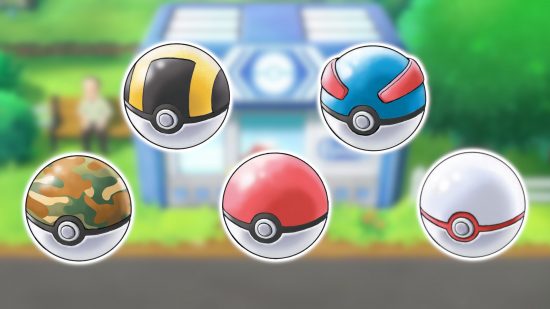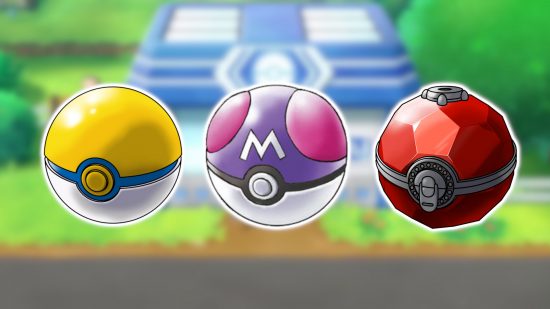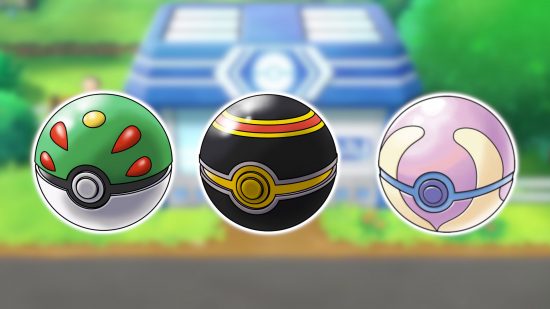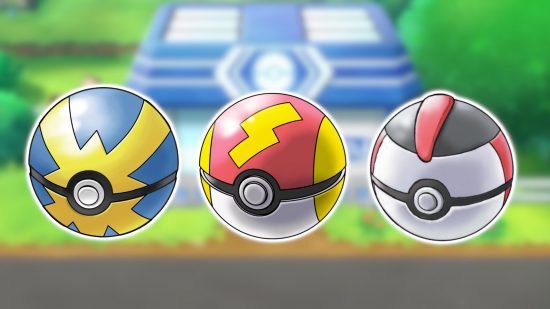If you’ve ever wondered which of the Pokéball types to use in a certain situation in Pokémon, we’re here to walk you through all of their different uses. There are a lot of them, so prepare to take notes, or bookmark this page so you always know which ball to use when. That’s probably a bit easier.
We at Pocket Tactics have a lot of opinions on Pokémon, and we think you should read them. So while you’re here, check out our guide to the best gen 5 Pokémon, the best mythical Pokémon, and the best starter Pokémon. See if you have the same opinions as we do.
Now let’s get into all of the Pokéball types.

Standard Pokéballs
These are your basic balls made for catching Pokémon in the wild. They’re suitable for almost every situation you could find yourself in.
Poké Ball
The Poké Ball is the base standard for balls in the Pokémon franchise. Its classic red and white design is the most recognizable of all the balls, and it’s the first tool you get as an aspiring Pokémon trainer.
Great Ball
The Great Ball is a step up from the Poké Ball, with a 1.5x catch rate modifier compared to the Poké Ball’s base one. It’s good for catching those slightly stronger Pokémon or for using when you don’t want to knock the Pokémon’s health down too low.
Ultra Ball
The Ultra Ball is the next step up, offering a 2x catch rate modifier and a sleek black and yellow design. They’re great for using in the late game.
Premier Ball
There’s nothing special about Premier Balls other than their design. They’re essentially just reskinned Poké Balls, and their in-game description suggests they were made to commemorate an event.
Safari Ball
You used to only be able to use the Safari Ball in safari parks in certain Pokémon games, but as of the Pokémon Sword and Shield Isle of Armor DLC, you can obtain and use it in regular gameplay.

Guaranteed Capture Pokéballs
There are some balls that are guaranteed to catch any Pokémon you find, but they are hard to come by, so make sure to use them wisely.
Master Ball
The Master Ball is the original guaranteed capture ball. You only get one of them, and the assumption is that you use it to catch the game’s legendary Pokémon. In recent years it’s become a bit of a meme to use the Master Ball on a random weak Pokémon instead.
Park Ball
Generation four introduced this ball and it has a guaranteed capture rate when used in a Catching Show in Pal Park or Ramanas Park in Pokémon Brilliant Diamond Shining Pearl. This is part of the process for transferring Pokémon over from generation three games to generation four. Otherwise, it’s just a regular Poké Ball with a different color palette.
Origin Ball
This ball is technically the in-universe precursor to the Master Ball. It’s used in the end game of Pokémon Legends: Arceus to automatically catch either Origin Forme Dialga or Palkia.

Caring Pokéballs
These Pokéballs show your Pokémon just how much you care about them!
Heal Ball
The Heal Ball does what it says on the tin really. It has a standard catch rate, but when you catch a Pokémon in it, their HP and PP is fully restored and they’re cured of any status conditions. It’s like a Pokémon center in your pocket! Plus, it has an adorable design in our opinion.
Luxury Ball
This ball has a top-notch design and is great for making your Pokémon feel special. It doubles the rate that the caught Pokémon’s friendship level increases, so it’s a great tool to have around when seeking those friendship-based evolutions, like some of the Eevee evolutions.
Friend Ball
If you can’t get your hands on a Luxury Ball, try the Friend Ball instead! It sets the Pokémon’s friendship level to 200 (or 150 in generation eight) so is also perfect for speeding up friendship-based evolutions.

Speed-based Pokéballs
Speed and timing can be essential to a successful Pokémon catch, especially when using these balls.
Quick Ball
This ball has a 5x catch rate modifier when used on the first turn of a battle, so it’s great to use when completing your Pokédex, especially before you have access to False Swipe.
Fast Ball
Not to be confused with the Quick Ball, the Fast Ball’s success rate is dependent on the base speed of the Pokémon you’re catching. It’s four times better at catching a Pokémon




